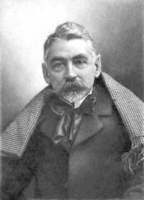阅读斯特芳·马拉美 Stephane Mallarme在诗海的作品!!! | |||
著有《诗与散文》、诗集《徜徉集》等。长诗《希罗狄亚德)(1875)、《牧神的午后》 (1876)是他著名的代表作。马拉美的诗歌幽晦而神秘,将世态的坎坷、变故变成了语言的柔韧飘逸的舞姿,将心灵的甘苦演变成天籁般的音韵意趣。在近40年的诗歌生涯中,他天才的火焰,擦亮了无数颗热爱诗歌的灵魂,尤其是许许多多年轻人的心灵,无不被他语言的幽闭、奢华、孤傲,以及浩美所折服。诗人晚年的诗作《骰子一掷,不会改变偶然》(1897)晦涩难懂,是马拉美最令人困惑的一首诗。这首诗的文字排列非常奇持,它有时呈楼梯式,有时一行只有一个字,有时一页只有一个字或几个字。马拉美企图描画出思维同混乱的宇宙接触的历程,他力图洞穿宇宙的奥秘和法则。这个历程也是诗人将字句写到纸上,寻求能够表现现实的语言结合的过程。这首诗无论在语言、诗句,还是在韵律方面,都大大革新了诗歌创作,直接迈向了20世纪的诗歌。
马拉美的诗歌主要特点表现在:1.追求语言美、句法多变化和音乐性,确立了自由诗的形式;2.诗歌有多种象征含义,导致晦涩难懂;后期诗作尤其如此,需要读者去发现含义,3.具有深奥的哲理。
He was born in Paris. He worked as an English teacher, and spent much of his life in relative poverty; but he was a major French symbolist poet and rightly famed for his salons, occasional gatherings of intellectuals at his house for discussions of poetry, art, philosophy. The group became known as les Mardistes, because they met on Tuesdays (in French, mardi), and through it Mallarmé exerted considerable influence on the work of a generation of writers (see below).
Édouard Manet, Portrait of Stéphane Mallarmé, 1876His earlier work owes a great deal to the style established by Charles Baudelaire. His fin-de-siècle style, on the other hand, anticipates many of the fusions between poetry and the other arts that were to blossom in the Dadaist, Surrealist, and Futurist schools, where the tension between the words themselves and the way they were displayed on the page was explored. But whereas most of this latter work was concerned principally with form, Mallarmé's work was more generally concerned with the interplay of style and content. This is particularly evident in the highly innovative Un coup de dés jamais n'abolira le hasard ('A roll of the dice will never abolish chance') of 1897, his last major poem.
French literature
By category
French literary history
Medieval
16th century · 17th century
18th century · 19th century
20th century · Contemporary
French writers
Chronological list
Writers by category
Novelists · Playwrights
Poets · Essayists
Short story writers
France portal
Literature portal
This box: view • talk • edit
Some consider Mallarmé one of the French poets most difficult to translate into English. This is often said to be due to the inherently vague nature of much of his work, but this explanation is really a simplification. On a closer reading of his work in the original French, it is clear that the importance of sound relationships between the words in the poetry equals, or even surpasses, the importance of the standard meanings of the words themselves. This generates new meanings in the spoken text which are not evident on reading the work on the page. It is this aspect of the work that is impossible to render in translation (especially when attempting a more literal fidelity to the words as well), since it arises from ambiguities inextricably bound in the phonology of the spoken French language. It can also be suggested that it is this 'pure sound' aspect of his poetry that has led to its inspiring musical compositions (see below), and to its direct comparison with music.
A good example of this play of sound appears in Roger Pearson's book 'Unfolding Mallarmé', in his analysis of the Sonnet en '-yx'. The poem opens with the phrase 'ses purs ongles' ('her pure nails'), whose first syllables when spoken aloud sound very similar to the words 'c'est pur son' ('it's pure sound'). This use of homophony, along with the relationships and layers of meanings it results in, is simply impossible to capture accurately through translation.
For many years, the Tuesday night sessions in his apartment on the rue de Rome were considered the heart of Paris intellectual life, with W.B. Yeats, Rainer Maria Rilke, Paul Valéry, Stefan George, Paul Verlaine, and many more in attendance, as Mallarmé held court as judge, jester, and king.
He died in Valvins in 1898.
Influence
Mallarmé's poetry has been the inspiration for several musical pieces, notably Claude Debussy's Prélude à l'après-midi d'un faune (1894), a free interpretation of Mallarmé's poem L'après-midi d'un faune (1876), which creates powerful impressions by the use of striking but isolated phrases. Maurice Ravel set Mallarmé's poetry to music in Trois poèmes de Stéphane Mallarmé (1913). Other composers to use his poetry in song include Darius Milhaud (Chansons bas de Stéphane Mallarmé, 1917) and Pierre Boulez (Pli selon pli, 1957-62).
The visual artist Marcel Broodthaers was strongly influenced by Mallarmé, as evidenced by his Un coup de Dés, based on the typographical layout of Mallarmé's, but with the words blacked over by bars.
Stéphane Mallarmé as a faun, cover of the literary magazine Les hommes d'aujourd'hui, 1887.The Dadaist artist Man Ray's last film, entitled Les Mystéres du Château du Dé (The Mystery of the Chateau of Dice) (1929), was greatly influenced by Mallarmé's work, prominently featuring the line "A roll of the dice will never abolish chance," from the poem by Mallarmé of the same name.
It has been suggested by some that much of Mallarmé's work influenced the conception of hypertext, with his emphasis on the importance of space and placement on the page. This becomes very apparent in his work "Un coup de dés jamais n'abolira le hasard" ('A roll of the dice will never abolish chance'). The placement of the words, the relationship between form and content, and all the different ways, combinations and permutations that one can read the poem are truly groundbreaking.
Works
In 1875, he translated Edgar Allan Poe's The Raven into French, while Impressionist painter Edouard Manet illustrated it.
L'après-midi d'un faune, 1876
Les Mots anglais, 1878
Les Dieux antiques, 1879
Divagations, 1897
Un coup de dés jamais n'abolira le hasard, 1897
Poésies, 1899 (posthumous)
Mallarmé: The Poems (trans. Keith Bosley, 1977)
